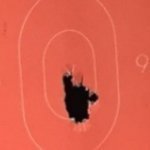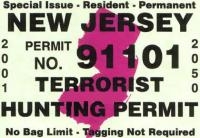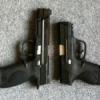Leaderboard
Popular Content
Showing content with the highest reputation on 01/29/2020 in all areas
-
8 pointsHe is a beauty all right. Done more for the 2A community that you ever would or could. If you dont know the facts you should keep your mouth shut.
-
7 points
-
6 pointsI concur with the mod in the sombrero! Seriously, @AVB-AMG.. I've been lucky enough to attend quite a few events that had high-level speakers (e.g., George W. Bush while he was POTUS, Madeline Albright, Shirley Chisholm, etc.). There's always a certain amount of pomp and circumstance when a high-level speaker is afoot, particularly a sitting POTUS (POTUS swaggers in with a cadre of Secret Service agents - it's kinda badass really)… and that stands separate and apart from their actual political views. As others pointed out, they're big, newsworthy events - especially in our tiny garden state. How's this? If the next Democratic president holds a rally in NJ, feel free to put it in General Discussion!
-
5 points
-
5 points
-
4 points
-
4 pointsIf a shop tells me it's store policy that I show an FID card, I shrug and hand it over. Their store, their rules. If a shop tells me state law requires it, I leave, because I won't know what else they are lying to me about.
-
4 pointsHere's the data from the ticket requests from Brad Parscal: Brad Parscale - Text TRUMP to 88022 @parscale Wow! New Jersey Data: 158,632 Requested Tickets (92,841 distinct signups) 73,482 Voters Identified 10.4% Didn't Vote in 2016 26.3% Democrats Mind boggling. 7:35 PM · Jan 28, 2020 ------------------------------------------- And if you were thirsty at the Rally, they had that covered too... check out the last one:
-
3 pointsLooks like a good one for NJ gun owners. Its a start in the right direction. https://www.ammoland.com/2020/01/nj-supreme-court-unanimously-rules-in-favor-of-gun-rights-wait-what/?fbclid=IwAR1H2xT3HJji7C2UVTDiLWtaHnGKpK0UcsyMv-C_HtH30aDBr_xj7-77Nlo#axzz6CEiE3vdf
-
3 points^^^^^THIS^^^^^ ALL DAY LONG! Being nice and answering questions is superior customer service. I pay a little extra for that and I'm fine with it. Most do the same. When I ran my photo studio I used to ask prospective customers that interviewed me if they wanted something to drink: Coffee, tea, soda, wine, beer, sparkling water. Yes, I had it all, and YES I wrote it all off! Once you hand someone a comp, a part of them is now connected to you. So they feel like they OWE you some business (in various intensities depending upon the person, and if food is also included). Easiest way to keep someone BUYING in your store is to FEED THEM so I had pizzas & salads delivered all the time. You bought a rifle, YOU WANT A SCOPE FOR THAT? Always ASK FOR THE FRIES just like McDonald's! Giving a prospective client something to drink means they might have to use the restroom. Guess where I hung sample pictures, testimonials, and industry awards & accolades in frames? You guessed it---the RESTROOM! For it is a SILENT SALESMAN! We used nice hand soap & paper towels and cleaned it several times a week. I've actually had folks compliment my restroom and ASK TO BOOK as soon as they exited it.... Sales is a psychological union between seller & buyer. And Mom & Pop's that wanna survive & thrive need to figure THAT out
-
3 pointsI always felt like I'm being bent over by NJ gun laws as it is. When I go into what I consider a friendly place like a gun shop that understands what hoops we have to jump through just to purchase (NOT TO CARRY) than that friendly place starts making up more rules and laws of their own I won't be back. Last month I bought a gun in a free state. I rented one, walked over to the sales counter and bought it. All in All it took over an hour not weeks or months like NJ. The last thing NJ needs is more B/S laws. Gun shops should know that.
-
3 pointsMipafox was controversial and at times a ball breaker but he was ALWAYS on our side! He would become obnoxious when he saw people complaining about NJ gun laws but never getting off their asses to fight back and do something about it!
-
3 points
-
3 pointsLets be honest. The reasons a gun store wont let a person without an FID handle a firearm are the following. 1. Stops the sales person from wasting time with a person who was bored while he waits for his reservation for dinner and thinks going to a gun store and playing with stuff is a good waste of time. 2. Stops people from out of state who are just passing though (New Yorkers) want wanting to see a gun store which they hardly see in the five boros. 3. The person might not even be prohibited and will never own a firearm so why bother wasting someones time. Its really similar to a Car showroom not wanting to waste time time with a 16yo who's getting his Lic in 6 months from playing in the cars and taking up the sales persons time. We usually handle it slightly different.... We have had a few people come in without FID cards... We are do answer questions they have but when they start wanting to see firearms i usually tell them You are a few steps away form that....You need to get your FID first then we would be happy to spend whatever time you need to choose your first gun. The key is to not be a dick.... You can give people the time without wasting it by just multitasking..
-
3 points
-
3 pointsSo, now do we all start applying and clogging courts with these cases?
-
3 points
-
2 pointsOk, now that is one is off the rails, too. Let's work out the logic of it Unless the law changed and I missed it, the law doesn't an require an FPID to purchase a pistol. The law doesn't require an FPID to rent a pistol. The law doesn't require an FPID to transport a pistol The law doesn't require an FPID to own a pistol And now some store clerk is telling me the law requires me to have an FPID to handle an pistol at a gun store? GTFO with that BS. Tell me it's store policy and I'm ok with that. Tell me it's the law and I'm out of there. But, otoh, NJ does require an FPID to buy pistol ammo, but still.
-
2 pointsI look in the mirror every day and I like what I see. I dont begrudge people for their successes. I envy them. I can only hope to achieve what some others have. I support their efforts, not belittle them. Who do you think is behind the scenes fighting for your rights every day? Have you sent your ballot in yet?
-
2 pointsThey require a Amex black card to afford their prices as well lol
-
2 pointsYeah, maybe it is all of the people that left NJ because of the high taxes, corruption, crime and lack of freedom returning to their homeland to stand for America and liberty.. Oh wait, no politics, right. AVB are there any good Hotdog or Pizza places in Wildwood?
-
2 points
-
2 points@Mrs. Peel smaller towns often share radio frequencies with am adjacent town or towns. There are also county wide and state wide police frequencies. I didn't look at the bordering towns but the town this happened in has a patrol division of 27 officers for its 10 square miles. They probably only have 3-5 of those officers on the streets at the time of the incident. The incident appears to have been called in as taking a report of suspicious activity that had occurred. Most likely one officer responded to the call. The suspect car went by as he was taking the report. I looked at a map and the distance from where the chase started to the Route 46 exit from I80 is about 2 miles. At 60 mph that takes 2 minutes. I'm sure that speed was exceeded. The short answer to your question is many police departments have fewer people on the street during late hours. That plus the fact they had maybe 2 minutes to coordinate "heading them off at the pass". A combination of officers available, officers close enough to get involved, and time. Hope this answers your question.
-
2 points
-
2 points
-
2 pointsCorrect. With an A5 receiver extension, you can use a 11.5” barrel and not pin&weld the muzzle device.
-
2 pointsA standard carbine buffer tube and 11.5” barrel (unpinned), is just shy of 26”. The A5 tube should be fine unpinned.
-
2 pointsThe television and radio media circus attention after Koby Bryant’s unfortunate death from that helicopter crash, is absolutely ridiculous and over the top! It just goes to show just how much our society has devolved to today and what/who it really values: idol worship of celebrities! These celebrities include professional athletes and film/television actors, pop musicians, etc, some who have used their platform for beneficial causes, while others are just intoxicated by the adulation of the masses and sometimes do not handle all of that attention very well. While Bryant's death was certainly sad, either ignoring or worse yet, the revisionist history about his sexual assault allegation, as well as the sudden glorification of him as a person, placing him on some silly high pedestal, is totally out of control. He was a very talented professional basketball player who also helped kids... all-in-all, better than many folks. But anyone paying attention realizes that the mainstream media just wants to get more clicks, eyeballs and ratings by sensationalizing his death and discussing it ad nauseam. Worse yet are the other celebrities who are blatantly outdoing each other to fawn over Bryant, making any historical contact with him into some important moment in their lives and then tearfully discussing his passing, for their own benefit, (i.e. Ellen Degeneres and Jimmy Fallon, etc.).... Enough already! AVB-AMG
-
2 points
-
1 point@Ray Ray Here's a pic I just found from the Hunt (it's not in my story). Armen with his Henry .44 Mag lever & his harvest. One & DONE right between the eyes! That lever is a real "brush-buster" too!
-
1 pointYea brand new is gonna be tough to find one without the tube. If you look on the EE at AR15.com, Im sure you could find one tho.
-
1 pointNo. Its just a standard 6 position tube- the same one comes with the SBA3 and is the one almost everyone uses on their rifle stocks.
-
1 point
-
1 pointIts the nothing burgers of NJ that allowed our rights to be taken from us by life's to short politicians in Trenton.
-
1 pointWhere? Why right back to the sales personnel that treated them RIGHT the first time! Sales is all about building relationships. Your example above is excellent in that regard and further proves my points. I've actually had customers come to me that were recommended by FOLKS THAT DIDN'T HIRE ME because I was just outside their price range. These same prospects kept telling their friends "Horror Stories" of piss-poor customer service they received from the "cheaper guy" and were WARNING THEIR FRIENDS NOT TO CHEAP-OUT LIKE THEY DID! You simply can't buy that type of word-of-mouth advertising. These "non-clients" got a Christmas Card from me every year, and when another family member needed photography for a popular October Saturday, I got a credit card deposit OVER THE PHONE when they scheduled their appointment to pick out which package they wanted to buy. The DECISION of WHERE TO BUY was already made.... Relationships. A slice of pizza, a bottle of water on a hot day, a nice hot chocolate on a cold winter day. A firm handshake & look them in the eyes. Or in the case of a FFL, remembering YOU are looking for something hard-to-find, and when it comes in from an estate sale next week, next month or next year, the FFL you have a great RELATIONSHIP with calls you on the phone PRIOR to putting the item on display! Sales is RELATIONSHIPS!
-
1 pointIt takes a certain kind of person to undertake this job likewise a fire fighter...…..it's certainly not for everyone.
-
1 pointIf you’re ever out in Milford Ct, take the tour, see the museum. Totally worth it, very educational.
-
1 pointI hate “Live PD” as do most officers I know. Anyway, below is the NJAG’s Office Policy that governs pursuits in NJ. Keep in mind that every state is different. What happens on “Live PD” may or may not be tolerated in this state, or a particular county, or a particular jurisdiction, and vice-versa. The below wall of text is everything you must remember and consider between observing a qualifying vehicle and hitting the lights/sirens to initiate an actual pursuit and what you must constantly monitor and assess while contemplating continuing or abandoning a pursuit. Keep in mind that a pursuit, as defined below, is different than a car that merely won’t stop right away when you hit the lights/sirens. In developing the policy revisions issued in 1993, the New Jersey Task Force on Police Vehicular Pursuit Policy was mindful of the requirement that such a policy appropriately weigh a police officer's sworn duty to apprehend lawbreakers with the obligation to protect life and the public safety. Throughout the process, each member of the Task Force worked conscientiously to reach a consensus in this area of critical importance. The 1993 policy revision significantly broadened the scope of the 1985 guidelines. The Task Force was particularly cognizant of the important role played by police supervisors in the implementation of any pursuit policy. Police supervisors occupy a pivotal role in assessing the degree of risk inherent in any pursuit and in properly balancing that risk against the need to apprehend a fleeing offender. The 1993 policy outlined the responsibility of police supervisors to manage and control pursuit activity. The 1999 policy revision provides law enforcement agencies with the discretion to use authorized tire deflation devices during vehicular pursuits. The Task Force was convinced early on that any sound vehicular pursuit policy is necessarily based on complete and accurate information about pursuit incidents. In order to ensure that such information is continually available, the policy requires that all law enforcement officers engaged in pursuit incidents file a pursuit incident report. The Task Force did not take lightly the imposition of another reporting requirement. It did, however, strongly believe that the risks and potential consequences inherent in the conduct of vehicular pursuits are such that this measure is warranted. The Task Force considered the entire range of incidents for which police officers are now required to file formal reports and concluded that vehicular pursuits would rank among the most critical on any such list. The Task Force strongly believed that the value of its efforts will ultimately be determined by the manner in which this policy is implemented. Successful implementation will be a direct result of the effort invested to train and inform police officers about the policy's content. Toward that end, the policy requires that all police officers attend in-service vehicular pursuit training twice a year. The Task Force knew that the policy had to provide specific guidance as to the conditions under which the initiation of pursuits should be authorized. Some of the most difficult issues considered by the Task Force arose as it dealt with this key portion of the policy. The Task Force readily concluded that the severity of 1st and 2nd degree crimes was such that law enforcement officers should have the discretion to pursue, but the appropriate course of action was not so quickly apparent with respect to some other offenses. The question of how to deal with the 3rd degree offense of car theft is complex and not susceptible to easy resolution. While the Task Force found that the majority of pursuits statewide were for motor vehicle offenses, a number of pursuits undertaken during the three year period reviewed were pursuits of stolen cars. Task Force members were also aware that tragic consequences have occurred over the same period as a result of some stolen car pursuits. Such tragedies, no matter how infrequent, certainly militate against authorizing the pursuit of car thieves. Nonetheless, car theft is a particularly egregious problem in our society at the present time. Not only has car theft become epidemic in some of our communities, but experience has shown that it is often the prelude to the commission of more serious violent crime. We would not, by a blanket prohibition of such pursuits, want to send a false signal to would-be car thieves that they can go about their illegal business with impunity. There is no simple, guaranteed correct answer to this policy question. The Task Force believed that in the final analysis, pursuit of stolen cars, like other serious crimes, must be left to the discretion of the police officer. Of course, the policy makes it clear that if there are other viable means to apprehend a car thief, or if there is a fair likelihood that the car thief can and will be apprehended within a reasonable future time, or if the risks involved in the pursuit are simply too substantial, then a vehicular pursuit should be avoided. Also, it should be clear that this policy is not meant to imply that prolonged pursuit should be a routine response to joy riding if such a situation could be reasonably determined in advance of the pursuit. As is so often true with difficult law enforcement issues, an oversimplified and quick response to a complex problem does not often serve the best interests of either the police or the public. It is the consensus of the Task Force that pursuits of stolen automobiles, as with all other pursuits, should be avoided whenever possible. However, the Task Force also believes that relying on the combined judgement of police officers and police supervisors will sufficiently safeguard the public. NEW JERSEY POLICE VEHICULAR PURSUIT POLICY PURPOSE OF POLICY The primary purpose of this policy is to secure a balance between the protection of the lives and safety of the public and police officers, and law enforcement's duty to enforce the law and apprehend violators. Since there are numerous situations which arise in law enforcement that are unique, it is impossible for this policy or any standard operating procedure to anticipate all possible circumstances. Therefore, this policy is intended to guide a police officer's discretion in matters of vehicular pursuit. This policy has been formulated to provide minimum statewide requirements to direct law enforcement activities in this very critical area of police practice. However, police department size, population density and other characteristics vary among communities in this state. Therefore, county and local law enforcement agencies are expected to develop individual standard operating procedures which account for departmental variations, yet are consistent with this policy. Deciding whether to pursue a motor vehicle is among the most critical decisions made by law enforcement officers. It is a decision which must be made quickly and under difficult, often unpredictable circumstances. In recognition of the potential risk to public safety created by vehicular pursuits, no officer or supervisor shall be criticized or disciplined for a decision not to engage in a vehicular pursuit or to terminate an ongoing vehicular pursuit based on the risk involved, even in circumstances where this policy would permit the commencement or continuation of the pursuit. Likewise, police officers who conduct pursuits consistent with this policy will be strongly supported by the law enforcement community in any subsequent review of such actions. DEFINITIONS A. Authorized Tire Deflation Device: A device designed and intended to produce a controlled deflation of one or more tires of a pursued vehicle, and capable of operation consistent with criteria established in this policy. B. Boxing In: The surrounding of a violator's moving vehicle with moving pursuit vehicles which are then slowed to a stop along with the violator's vehicle. C. Divided Highway: A road which includes a physical barrier between traffic traveling in opposite directions. D. Heading Off: An attempt to terminate a pursuit by pulling ahead of, behind or toward a violator's moving vehicle to force it to the side of the road or to otherwise come to a stop. E. Law Enforcement Officer: Any person sworn to uphold the laws of the State of New Jersey, and who is certified by the Police Training Commission or whose training has included Pursuit/Emergency Driving, and who is currently employed by a public safety agency. F. Paralleling: 1. Street Paralleling: Driving a police vehicle on a street parallel to a street on which a pursuit is occurring. 2. Vehicle Paralleling: A deliberate offensive tactic by one or more patrol vehicles to drive alongside the pursued vehicle while it is in motion. G. Pursuit Driving: Pursuit driving is an active attempt by a law enforcement officer operating a motor vehicle and utilizing emergency warning lights and an audible device to apprehend one or more occupants of another moving vehicle when the officer reasonably believes that the driver of the fleeing vehicle is aware of the officer's attempt to stop the vehicle and is resisting apprehension by increasing vehicle speed, ignoring the officer or otherwise attempting to elude the officer. H. Pursuit Vehicles: 1. Primary Unit: The police vehicle that initiates a pursuit or any unit that assumes control of the pursuit as the lead vehicle (the first police vehicle immediately behind the fleeing suspect). 2. Secondary Unit: Any police vehicle which becomes involved as a backup to the primary unit and follows the primary unit at a safe distance. I. Roadblock: A restriction or obstruction used or intended for the purpose of preventing free passage of motor vehicles on a roadway in order to effect the apprehension of a violator. 1. Avenue of Escape: A gap in a roadblock which requires the violator to decrease the vehicle's speed to permit the violator to bypass the roadblock. 2. Blocking Vehicle: A motor vehicle, often a law enforcement vehicle, which is placed perpendicular to a roadway or angled in such a way as to create a roadblock. J. Supervisor: A police officer who, by virtue of rank or assignment, is responsible for the direction or supervision of the activities of other police officers. K. Vehicle Contact Action: Any action undertaken by the pursuing officer intended to result in contact between the moving police vehicle and the pursued vehicle. L. Violator: Any person who a police officer reasonably believes: (1) has committed an offense of the first or second degree or an offense enumerated in Appendix A of this policy, or (2) poses an immediate threat to the safety of the public or other police officers. I. DECIDING WHETHER TO PURSUE A police officer has the authority, at all times, to attempt the stop of any person suspected of having committed any criminal offense or traffic violation. It is clear that while it is the officer who initiates the stop, it is the violator who initiates the pursuit. The officer's decision to pursue should always be undertaken with an awareness of the degree of risk to which the law enforcement officer exposes himself and others. The officer must weigh the need for immediate apprehension against the risk created by the pursuit. A. Authorization to Pursue 1. A police officer may only pursue a. When the officer reasonably believes that the violator has committed an offense of the first or second degree, or an offense enumerated in Appendix A of this policy, or b. When a police officer reasonably believes that the violator poses an immediate threat to the safety of the public or other police officers. 2. Pursuit for motor vehicle offenses is not authorized under the above criteria unless the violator's vehicle is being operated so as to pose an immediate threat to the safety of another person. B. In the event that one of the authorization requirements is satisfied, a pursuit should not be automatically undertaken. An officer must still consider the following factors: 1. Likelihood of successful apprehension. 2. Whether the identity of the violator is known to the point where later apprehension is possible. 3. Degree of risk created by pursuit a. Volume, type, speed and direction of vehicular traffic. b. Nature of the area: residential, commercial, school zone, open highway, etc. c. Population density and volume of pedestrian traffic d. Environmental factors such as weather and darkness e. Road conditions: construction, poor repair, extreme curves, ice, etc. 4. Police Officer characteristics a. Driving skills b. Familiarity with roads c. Condition of police vehicle C. Terminating the pursuit 1. The pursuing officer shall terminate the pursuit a. If instructed to do so by a supervisor, or b. If the officer believes that the danger to the pursuing officers or the public outweighs the necessity for immediate apprehension of the violator, or c. If the violator's identity is established to the point where later apprehension may be accomplished and where there is no immediate threat to the safety of the public or police officers, or d. If the pursued vehicle's location is no longer known or the distance between the pursuing vehicles and the violator's vehicle becomes so great that further pursuit is futile, or e. If there is a person injured during the pursuit and there are no police or medical personnel able to render assistance, or f. If there is a clear and unreasonable danger to the police officer or the public. A clear and unreasonable danger exists when the pursuit requires that the vehicle be driven at excessive speeds or in any other manner which exceeds the performance capabilities of the pursuing vehicles or police officers involved in a pursuit, or g. If advised of any unanticipated condition, event or circumstance which substantially increases the risk to public safety inherent in the pursuit. II. ROLE OF THE PURSUING OFFICER A. The decision to initiate and/or continue a pursuit requires weighing the need to immediately apprehend the violator against the degree of risk to which the officer and others are exposed as a result of the pursuit. B. Upon the commencement of a pursuit, the pursuing officer will immediately activate emergency lights, audible device and headlights. C. Once the pursuit has been initiated, the primary unit must notify communications and a superior officer providing as much of the following information as is known: 1. Reason for the pursuit. 2. Direction of travel, designation and location of roadway. 3. Identification of the violator's vehicle: year, make, model, color, vehicle registration number and other identifying characteristics. 4. Number of occupants. 5. The speed of the pursued vehicle. 6. Other information that may be helpful in terminating the pursuit or resolving the incident. III. VEHICULAR PURSUIT RESTRICTIONS A. No pursuits will be conducted 1. In a direction opposite to the flow of traffic on a divided highway. 2. In a police vehicle in which an individual who is not a law enforcement officer is either the driver or passenger. B. No more than two police vehicles (primary unit and secondary unit) shall become actively involved in a pursuit unless otherwise specifically directed by a supervisor. C. A motorcycle officer may initiate a pursuit, but will relinquish primary unit status immediately upon the participation of a marked police vehicle. D. An unmarked police vehicle will not participate in a vehicular pursuit unless it is equipped with an emergency light and an audible device. The unmarked car shall relinquish primary unit status immediately upon the participation of a marked vehicle. E. To diminish the likelihood of a pursuit, a police officer intending to stop a vehicle for any violation of the law shall, when possible and without creating a threat to public safety, close the distance between the two vehicles prior to activating emergency lights and an audible device. F. Throughout the course of a vehicular pursuit, pursuing officers shall not attempt to overtake or pass the violator's moving vehicle. G. Upon approaching an intersection controlled by traffic signals or signs, or any other location at which there is a substantially increased likelihood of collision, the operator of any pursuit vehicle shall, prior to entering the intersection, reduce the vehicle's speed and control the vehicle so as to avoid collision with another vehicle or a pedestrian. The officer shall observe that the way is clear before cautiously proceeding through the intersection. H. Officers involved in a pursuit will not engage in vehicle paralleling. I. There shall be no street paralleling along the route unless the pursuit passes through a patrol's assigned area. A patrol that is parallel-street-pursuing shall not join or interfere with a pursuit, and shall stop all pursuit-related activity at the boundary of its assigned area. J. Boxing in or heading off a violator's moving vehicle is permitted only under extraordinary circumstances. These tactics substantially increase the risk inherent in the pursuit and shall only be employed: 1. At low speeds, and 2. With the approval of a supervisor, or 3. In response to an imminent threat to the safety of the public or a police officer. K. Roadblocks must only be employed as a last resort in circumstances where deadly force would otherwise be justified. 1. The use of a roadblock must be authorized by a supervisor. 2. At no time will a roadblock be established until all pursuing police vehicles are made aware of the roadblock and its location and have acknowledged this awareness. 3. Once a roadblock has been established and a vehicle or barricade has been positioned in the roadway, there shall be: a. adequate distance to see the roadblock b. an avenue of escape c. no one in the blocking vehicle(s). L. Officers involved in a pursuit shall not fire any weapon from or at a moving vehicle nor engage in any vehicle contact action except as a last resort to prevent imminent death or serious injury to the officer or another person where deadly force would otherwise be justified. IV. AUTHORIZED TIRE DEFLATION DEVICES A. Law enforcement agencies may choose to utilize authorized tire deflation devices during the course of a vehicular pursuit. Agencies which choose to employ this strategy may only utilize devices authorized by this policy. As with all operational decisions made during the conduct of a vehicular pursuit, the use of such devices is subject to the assessment of inherent risk balanced against the need to apprehend a fleeing offender. B. To be authorized for deployment and use under the vehicular pursuit policy, the tire deflation device must: 1. Be capable of producing a controlled deflation of one or more tires of a pursued vehicle; 2. Be capable of being placed in the roadway before activation and driven over by other traffic without causing damage to the vehicles; 3. Be capable of being activated immediately before the pursued vehicle drives over it, and deactivated immediately after the pursued vehicle drives over it; 4. Allow the officer to remain a safe distance from the roadway at the time of activation; and 5. Be capable of remaining in the roadway after activation and deactivation without causing damage to any vehicles. C. Prior to the deployment and use of an authorized tire deflation device, the law enforcement agency shall 1. Modify its vehicular pursuit policy to provide for the proper use of the authorized tire deflation device; and 2. Train all officers in the use of the authorized tire deflation device. a. Training must include practical, hands-on operation of the authorized tire deflation device. D. Use of an authorized tire deflation device 1. An authorized tire deflation device may be utilized only after supervisory approval. 2. An authorized tire deflation device shall not be used to stop motorcycles, mopeds, or similar vehicles. 3. The authorized tire deflation device should not be used in locations where specific geographic features (e.g., sharp curves, alongside of rivers, steep embankments, etc.) increase the risk of serious injury to the officer, violator or public. 4. Deployment locations should have reasonably good sight distances to enable the officer to observe the pursuit and other traffic as it approaches. 5. The officer deploying the authorized tire deflation device should not attempt to overtake and pass a high speed pursuit in order to position the device. E. Deployment 1. The officer deploying the authorized tire deflation device should do so from a position of safety. 2. The officer deploying the authorized tire deflation device should be in position to allow sufficient time for deployment. 3. The supervisor overseeing the pursuit must approve the location of the authorized tire deflation device. 4. The communications operator shall notify all units of the location of the authorized tire deflation device deployment. F. Activation of the authorized tire deflation device 1. The officer operating the authorized tire deflation device should take a position of safety as the pursued vehicle approaches. 2. After all other traffic has passed over the authorized tire deflation device, and immediately prior to the pursued vehicle passing over the authorized tire deflation device, the device shall be activated (exposing the spikes). 3. Immediately after the pursued vehicle goes over the authorized tire deflation device, the officer shall deactivate the device (retract the spikes). 4. The officer should immediately notify communications if the pursued vehicle impacted the authorized tire deflation device, if the officer observed any signs of deflation, and the direction and operation of the pursued vehicle after the impact. G. Removal of the authorized tire deflation device 1. As soon as practical, the authorized tire deflation device shall be removed from the roadway. H. Reporting 1. After deployment or use of the authorized tire deflation device, the law enforcement agency shall include the following information in the narrative of the vehicle pursuit report: a. Date, time and location of deployment b. Officer who deployed the authorized tire deflation device c. Supervisor who authorized the deployment of the authorized tire deflation device d. Date and time of activation e. Officer who activated the authorized tire deflation device f. Results of the use of authorized tire deflation device on the pursued vehicle g. Results of the use of the authorized tire deflation device on any other vehicle, property or person h. Results of the use on the authorized tire deflation device itself. V. ROLE OF THE SUPERVISOR Upon being notified or becoming aware of the pursuit, the supervisor shall decide as quickly as possible whether or not the pursuit should continue. A. The supervisor shall permit a pursuit to continue only if 1. There is a reasonable belief that the violator has committed an offense of the first or second degree, or an offense enumerated in Appendix A of this policy, or 2. There is a reasonable belief that violator poses an immediate threat to safety of the public or other police officers. B. The supervisor shall order a pursuit terminated at any time if he or she concludes that the danger to the pursuing officers or the public outweighs the necessity for immediate apprehension of the violator. C. The supervisor shall order the pursuit terminated if the suspect's identity is established to the point where later apprehension may be accomplished and where there is no immediate threat to public safety. D. In recognition of the overall population density and volume of vehicular traffic in this State, and the increased risk attendant to prolonged vehicular pursuits, a supervisor shall order the termination of any pursuit of protracted duration unless the supervisor determines that further pursuit is justified to respond to an immediate threat to public safety. E. The supervisor shall ensure, for the duration of the pursuit, that this policy and agency procedures are followed by all officers. VI. ROLE OF POLICE COMMUNICATIONS A. The communications operator shall: 1. Immediately notify a police supervisor of a pursuit in progress if a supervisor has not already been otherwise notified; 2. Keep the supervisor apprised of the duration and progress of the pursuit. B. When possible, a police supervisor shall determine whether there is a need to assume control over and coordinate pursuit related communications. C. All law enforcement agencies shall establish procedures to ensure that radio channels remain open for pursuit related transmissions and that all necessary information is made available to officers involved in the pursuit. VII. REINSTATING PURSUITS A. Reinstatement of any previously terminated pursuit shall be undertaken consistent with the authorization criteria for originally initiating a pursuit. VIII. INTERJURISDICTIONAL PURSUITS A. The original pursuing jurisdiction shall provide timely notification of a pursuit in progress to any other jurisdiction into which the pursuit enters. 1. Notifying another jurisdiction that a pursuit is in progress is not a request to join the pursuit. The pursuing agency shall advise if assistance is necessary. Whenever the pursuing officers are unfamiliar with the roadways and terrain of the jurisdiction into which the pursuit has entered, the pursuing agency shall, when possible, seek the assistance of, and be prepared to relinquish the pursuit to, the other agency. IX. PURSUIT REPORTING A. All law enforcement officers who operate law enforcement vehicles in vehicular pursuit situations shall be required to file a pursuit incident report. Pursuit incident reports are to be filed in a manner established by agency operating procedures and should contain, at a minimum, the following information: 1. Location, date and time of pursuit initiation. 2. Location, date and time of pursuit termination. 3. Highest speed achieved, weather conditions, road surface and description of pursuit area. 4. Reasons for initiating and terminating the pursuit. 5. Consequences of the pursuit, such as accidents, injuries or fatalities. 6. Whether or not the violator was apprehended. 7. The offenses with which the violator was charged. B. All law enforcement agencies shall prepare an annual agency Vehicular Pursuit Summary Report for submission to the county prosecutor. The annual report shall be submitted on the Police Vehicular Summary Report Form and shall contain the following information: 1. Total number of pursuits 2. Number of pursuits resulting in accident, injury, death and arrest. 3. The number and type of vehicles involved in accidents (police, violator, third party). 4. A description of individuals injured or killed (police, violator, third party). 5. The number of violators involved and arrested in pursuit incidents, including passengers. X. VEHICULAR PURSUIT REVIEW A. All law enforcement agencies shall establish procedures for the formal review of all pursuit incident reports. B. Pursuit incidents should be reviewed for compliance with applicable policy and department operating procedures. C. Pursuit incidents should also be reviewed to identify the need for remedial training of individual officers or specific areas of emphasis in agency-wide training regarding pursuit situations and the application of pursuit policies and procedures. D. Periodic review of pursuit incidents and summary pursuit information should be conducted in order to identify any additions, deletions or modifications warranted in departmental pursuit procedures. XI. TRAINING A. All officers shall attend in-service vehicular pursuit training twice annually. This in-service training shall be held simultaneously with use of force training which is provided in the firearms requalification process. B. Vehicular pursuit training shall consist of knowledge of applicable statutes, familiarization with statewide police pursuit policy and departmental procedures, and decision making skills. C. An annual report shall be filed with the county prosecutor or, in the case of certain state law enforcement agencies, with the Director of the Division of Criminal Justice. The report will confirm in-service pursuit training of all police officers in conjunction with semi-annual firearm requalification and the use of force training. INDIVIDUAL AGENCY POLICIES Law enforcement agencies may adopt more restrictive policies as to pursuit procedures or more extensive training and reporting requirements. In the event an agency chooses to do so, the agency policies and procedures will prevail with respect to applicability to that agency's personnel. APPENDIX A TO NEW JERSEY POLICE VEHICULAR PURSUIT POLICY OFFENSES IN ADDITION TO THOSE OF THE FIRST AND SECOND DEGREE FOR WHICH VEHICULAR PURSUIT MAY BE AUTHORIZED UNDER SUBSECTION IA(1)(a) Death by Auto 2C:11-5 Aggravated Assault 2C:12-1b Criminal Restraint 2C:13-2 Aggravated Criminal Sexual Contact 2C:14-3a Arson 2C:17-1b Burglary 2C:18-2 Automobile Theft 2C:20-2 Theft by Extortion 2C:20-5 Escape 2C:29-5 Manufacturing, Distributing or Dispensing of CDS 2C:35-5b
-
1 pointWhat happens if the hearing does not occur within 30 days? Is that an automatic approval or will that be ignored just like every other 30 day deadline in NJ?
-
1 pointi'm not sure.....but many towns down here near me all do share services. they seem to be on the same freqs and will regularly back each other up.
-
1 pointShe's got acreage and access to excavating equipment. Be careful!
-
1 point
-
1 point
-
1 point
-
1 pointIm surprised they didn’t try to moot the case after the directive was issued.
-
1 pointThe whole thing was on C-SPAN 2 uninterrupted. The crowd was lit! Bring it to the heart of the beast. Next time sell out the Meadowlands.
-
1 point
-
1 pointGetting ready to head down there in a little while. No hope of getting in (and no way I would have either the patience or stamina for that), but looking to hang out with like-minded people, and take in the whole experience. I'll be sure to report back in a day or so.
-
1 pointhttps://www.nj.com/news/j66j-2020/01/674b6387b96799/grills-signs-and-other-sights-from-the-day-before-the-trump-rally.html
-
1 pointThat's the first thought that came to my mind. Then I remembered there's a list of things that are only wrong if conservatives do them.


























